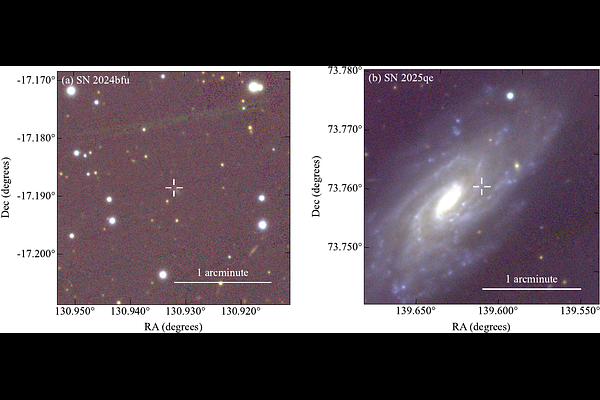SN 2024bfu, SN 2025qe, and the early light curves of type Iax supernovae

SN 2024bfu, SN 2025qe, and the early light curves of type Iax supernovae
M. R. Magee, T. L. Killestein, M. Pursiainen, B. Godson, D. Jarvis, C. Jiménez-Palau, J. D. Lyman, D. Steeghs, B. Warwick, J. P. Anderson, T. Butterley, T. -W. Chen, V. S. Dhillon, L. Galbany, S. González-Gaitán, M. Gromadzki, C. Inserra, L. Kelsey, A. Kumar, G. Leloudas, S. Mattila, T. E. Müller-Bravo, K. Noysena, G. Ramsay, S. Srivastav, R. Starling, R. W. Wilson, D. R. Young, K. Ackley, R. P. Breton, J. Casares Velázquez, M. J. Dyer, D. K. Galloway, E. Kankare, R. Kotak, L. K. Nuttall, D. O'Neill, P. Pessi, D. Pollacco, K. Ulaczyk, O. Yaron
AbstractType Iax supernovae (SNe Iax) are perhaps the most numerous class of peculiar thermonuclear supernova and yet their sample size, particularly those observed shortly after explosion, remains relatively small. In this paper we present photometric and spectroscopic observations of two SNe Iax discovered shortly after explosion, SN 2024bfu and SN 2025qe. Both SNe were observed by multiple all-sky surveys, enabling tight constraints on the moment of first light and the shape of the early light curve. Our observations of SN 2025qe begin <2 d after the estimated time of first light and represent some of the earliest observations of any SN Iax. We identify features consistent with carbon absorption throughout the spectroscopic evolution of SN 2025qe, potentially indicating the presence of unburned material throughout the ejecta. Inspired by our early light curve coverage, we gather a sample of SNe Iax observed by ATLAS, GOTO, and ZTF, and measure their rise times and early light curve power-law rise indices. We compare our findings to a sample of normal SNe Ia and find indications that SNe Iax show systematically shorter rise times, but the small sample size and relatively large uncertainties prevent us from identifying statistically significant differences in most bands. We find some indication that SNe Iax show systematically lower rise indices than normal SNe Ia in all bands. The low rise indices observed among SNe Iax is qualitatively consistent with extended $^{56}$Ni distributions and more thoroughly-mixed ejecta compared to normal SNe Ia, similar to predictions from pure deflagration explosions.